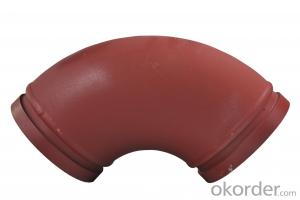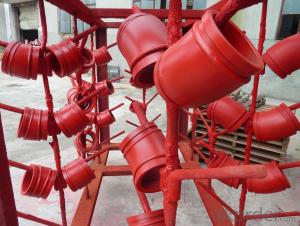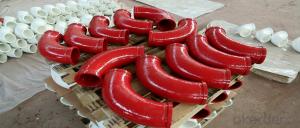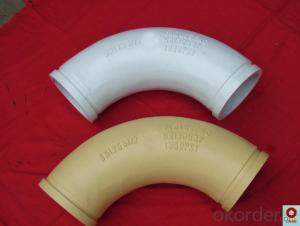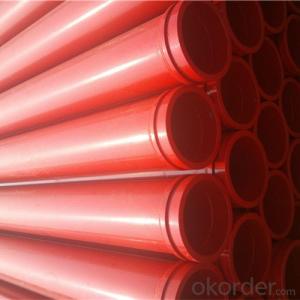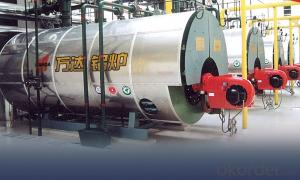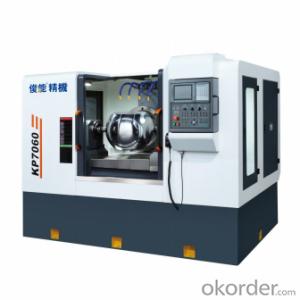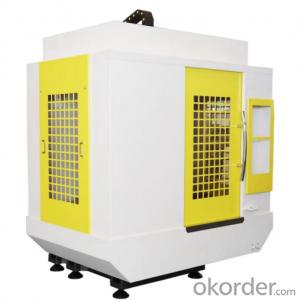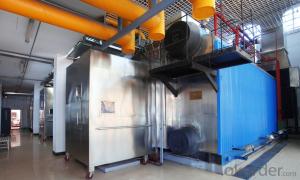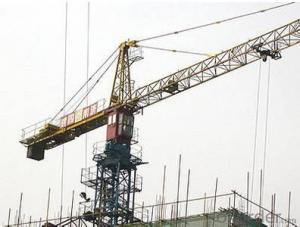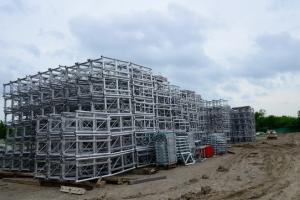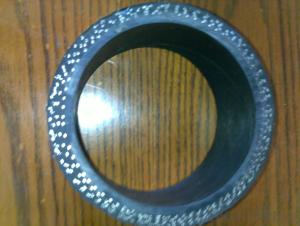Twin Wall Elbow for Concrete Pump R180 90DGR
- Loading Port:
- Tianjin
- Payment Terms:
- TT or LC
- Min Order Qty:
- 50 pc
- Supply Capability:
- 3000 pc/month
OKorder Service Pledge
OKorder Financial Service
You Might Also Like
Product Description:
Product Name: Twin Wall Pipe for Concrete Pump Pipe
Specification
(1) Material: Q235 (outside) + GCr15(inside)
(2) Thickness: 3mm (outside) + 9mm (inside)
(3) Technology: Quenching under high temperature
(4) Characteristics: the inner rigidity to 63 HRC; the outside has so high toughness to keep the inner.
(5) Matched with: Twin wall flange, Alloy (GCr15) + 20#
(6) Working Pressure:170bar
(7) Service life: above 60,000 cubic meters.
(8) Package: PP woven bag and plastic cap
3. Application
Concrete delivery.
4. Package
Put into containers.
FAQ:
Q1: Why buy Materials & Equipment from OKorder.com?
A1: All products have its ISO certifications, adheres to the highest standards and a commitment to supply chain safety and customer satisfaction.
Q2: How do we guarantee the quality of our products?
A2: We have established an advanced quality management system which conducts strict quality tests at every step, from raw materials to the final product. At the same time, we provide extensive follow-up service assurances as required.
Q3: How soon can we receive the product after purchase?
A3: Within three days of placing an order, we will begin production. The specific shipping date is dependent upon international and government factors, but is typically 10 to 30 workdays.
Q4: If we can produce Twin Wall Pipe for Concrete Pump Pipe Thickness 4.5mm Length 3000mm according to customers request?
A4: Yes, we can produce T Twin Wall Pipe for Concrete Pump Pipe Thickness 4.5mm Length 3000mm according to the difference country situations to make it suitable to the market and customers. We have very professional technical team to make the design.
Q5: How to make a quick resolution for after service?
A5: We have overseas branches all-around of world, If needed, the seller shall dispatch 2 engineers to the buyer's site for supervision of training. The buyer shall make available of necessary facilities &skilled personnel at site for training.
Images:
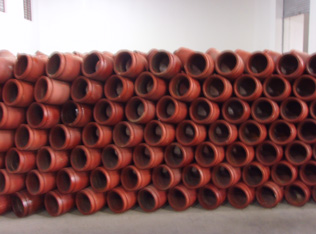
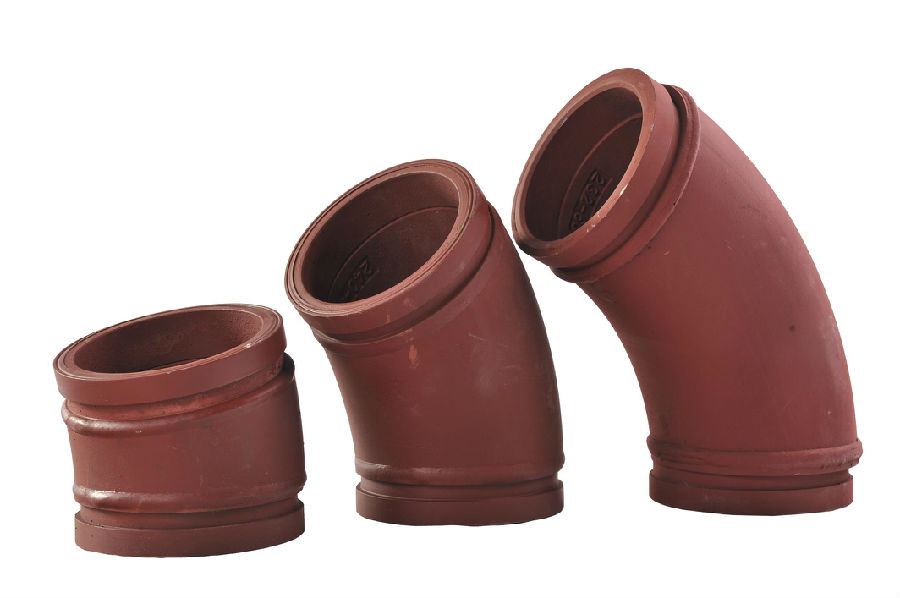
- Q:How do I properly adjust and control flow rates in concrete pump spare parts?
- To properly adjust and control flow rates in concrete pump spare parts, there are a few key steps to follow: 1. Understand the equipment: Familiarize yourself with the specific concrete pump spare parts you are working with. Read the user manual and refer to any documentation provided by the manufacturer. This will help you gain a comprehensive understanding of the equipment's capabilities and how to adjust flow rates effectively. 2. Check the pump settings: Before starting any concrete pumping operation, ensure that the pump settings are properly configured. This includes checking the hydraulic pressure, engine RPM, and any other relevant settings. Make sure all valves and controls are in the correct position for the desired flow rate. 3. Monitor the pump speed: The speed of the pump directly affects the flow rate of the concrete. Different concrete mixtures may require different pump speeds to achieve the desired flow rate. Adjust the engine RPM accordingly, referring to the manufacturer's recommendations and any specific requirements for the project. 4. Adjust the pump stroke: Most concrete pumps have adjustable pump strokes to control the flow rate. By changing the length of the stroke, you can increase or decrease the volume of concrete being pumped. Experiment with different stroke lengths to find the optimal flow rate for your specific application. 5. Use the control panel: Many concrete pumps come equipped with a control panel that allows for precise adjustment of flow rates. Take advantage of these features to fine-tune the flow rate. Use the control panel to monitor the pump's performance and make any necessary adjustments to maintain a consistent flow. 6. Regularly inspect and maintain the equipment: Proper maintenance is crucial to ensure the accurate adjustment and control of flow rates. Regularly inspect the concrete pump spare parts for any signs of wear or damage. Clean and lubricate the components as recommended by the manufacturer. A well-maintained pump will operate more efficiently and provide more accurate control over flow rates. By following these steps, you can properly adjust and control flow rates in concrete pump spare parts. Remember to always prioritize safety and consult the manufacturer's instructions and guidelines for specific recommendations and considerations.
- Q:What are the signs of wear and tear in concrete pump spare parts?
- Some signs of wear and tear in concrete pump spare parts include cracks or fractures in the components, excessive vibration or noise during operation, decreased performance or efficiency, leaks or drips from seals or connectors, and visible corrosion or rust on metal parts. Additionally, worn-out or damaged rubber gaskets, seals, or O-rings can also indicate the need for replacement.
- Q:How does a hopper vibrator prevent concrete blockages?
- A hopper vibrator prevents concrete blockages by vibrating the hopper, which helps to dislodge any stuck or compacted material, allowing it to flow freely through the hopper and preventing blockages.
- Q:How long do concrete pump spare parts typically last?
- There are several factors that can affect the lifespan of concrete pump spare parts. Generally, high-quality parts can last between 1,000 and 2,500 working hours. However, this estimate can be influenced by factors such as the type and brand of the spare parts, how often they are used, the quality of maintenance they receive, and the working conditions in which the concrete pump operates. Some spare parts for concrete pumps may have a shorter lifespan due to the wear and tear they experience during operation. For example, wear parts like rubber seals, pistons, and wear plates are more prone to damage and may need to be replaced more frequently. On the other hand, structural components like pipes, hoses, and hydraulic cylinders tend to last longer. Extending the lifespan of concrete pump spare parts relies on proper maintenance and regular inspections. Adequate lubrication, cleaning, and timely replacement of worn-out parts can significantly increase their durability. Additionally, the expertise and skill of the operator also play a role in the lifespan of the spare parts, as improper use or mishandling can lead to premature failure. While it is possible to estimate the average lifespan of concrete pump spare parts, it is important to consider the specific circumstances and conditions in which the concrete pump operates to determine their actual longevity. Regular maintenance, the use of high-quality parts, and proper usage will ultimately help maximize the lifespan of concrete pump spare parts.
- Q:What are the different types of concrete pump hydraulic pumps?
- Concrete pumps commonly utilize a variety of hydraulic pumps. Here are several types: 1. Gear pumps, which are widely employed in concrete pumps, consist of meshing gears that propel hydraulic fluid from the inlet to the outlet. Gear pumps are renowned for their simplicity, durability, and reliability. 2. Piston pumps, another popular choice in concrete pumps, employ reciprocating pistons to move hydraulic fluid. These pumps are known for their ability to handle heavy-duty applications and generate high pressure. 3. Vane pumps are often used in smaller concrete pumps or as auxiliary pumps in larger ones. They rely on rotating vanes within a housing to move the hydraulic fluid. Vane pumps are prized for their compact size and efficiency. 4. High-pressure concrete pumps commonly employ radial piston pumps. These pumps have multiple pistons arranged radially around a central shaft. The pistons' alternating motion creates the pumping action. Radial piston pumps are esteemed for their power and efficiency. 5. Large concrete pumps frequently utilize axial piston pumps. These pumps feature multiple pistons arranged in a circular pattern around a central shaft. The pistons move linearly to generate the pumping action. Axial piston pumps excel in high flow rates and pressure capabilities. Ultimately, the choice of hydraulic pump for a concrete pump depends on factors such as pump size, desired pressure and flow rate, and specific application requirements.
- Q:What are the common issues that require replacement of concrete pump spare parts?
- Concrete pumps can experience various issues that necessitate the replacement of spare parts. One prevalent problem is the gradual deterioration of pump components due to wear and tear. Continuous movement of concrete through the pump causes deterioration of parts like the piston, wear plate, and seals, which then need to be replaced. Another issue that may arise is blockages or clogs in the pump line. This occurs when hardened concrete or other debris accumulates, obstructing the flow of concrete. In such cases, replacing parts like the delivery pipe, hose, or even the entire pump line becomes necessary to ensure proper functioning. Leaks are also a common problem in concrete pumps. These leaks often result from damaged or worn-out seals, gaskets, or O-rings. If left unattended, leaks can lead to reduced pump performance and potential safety hazards. Replacing the affected parts helps prevent further damage and ensures efficient pump operation. Additionally, pump malfunctions can be attributed to electrical or mechanical issues. Faulty electrical components, such as switches or sensors, may require replacement to restore proper functionality. Mechanical problems, such as a worn-out gearbox or a malfunctioning hydraulic system, may also necessitate the replacement of specific pump parts. In summary, common issues that call for the replacement of concrete pump spare parts include wear and tear, blockages, leaks, electrical malfunctions, and mechanical failures. Regular maintenance and inspection of the pump enable early identification of these issues, allowing for timely replacement of the necessary spare parts to maintain smooth pump operation.
- Q:How often should concrete pump hydraulic oil coolers be inspected and maintained?
- Concrete pump hydraulic oil coolers should be inspected and maintained regularly, ideally on a monthly basis or as recommended by the manufacturer. Regular inspections and maintenance ensure optimal performance and help identify any potential issues or damage that may affect the efficiency and lifespan of the equipment.
- Q:Are there any warranties or guarantees on concrete pump spare parts?
- Yes, there are warranties and guarantees offered on concrete pump spare parts. Many manufacturers and suppliers provide warranties on their products to ensure the quality and performance of the spare parts. These warranties may vary in duration and coverage depending on the specific supplier or manufacturer. It is important to check with the supplier or manufacturer to understand the terms and conditions of the warranty or guarantee before purchasing the concrete pump spare parts. Additionally, some suppliers may also offer extended warranties or guarantees for an additional cost, providing further peace of mind to the customers.
- Q:What are the types, classifications and specifications of concrete pump?
- According to the maximum hourly transport rate, there are 20-100m3 range, and most of the concrete pump can achieve two variable displacement or stepless variable
- Q:Can I get spare parts for concrete pump hydraulic cylinders and valves?
- Yes, spare parts for concrete pump hydraulic cylinders and valves are generally available. It is recommended to contact the manufacturer or a reputable supplier to inquire about the specific parts you need for your concrete pump.
1. Manufacturer Overview |
|
|---|---|
| Location | |
| Year Established | |
| Annual Output Value | |
| Main Markets | |
| Company Certifications | |
2. Manufacturer Certificates |
|
|---|---|
| a) Certification Name | |
| Range | |
| Reference | |
| Validity Period | |
3. Manufacturer Capability |
|
|---|---|
| a)Trade Capacity | |
| Nearest Port | |
| Export Percentage | |
| No.of Employees in Trade Department | |
| Language Spoken: | |
| b)Factory Information | |
| Factory Size: | |
| No. of Production Lines | |
| Contract Manufacturing | |
| Product Price Range | |
Send your message to us
Twin Wall Elbow for Concrete Pump R180 90DGR
- Loading Port:
- Tianjin
- Payment Terms:
- TT or LC
- Min Order Qty:
- 50 pc
- Supply Capability:
- 3000 pc/month
OKorder Service Pledge
OKorder Financial Service
Similar products
New products
Hot products
Hot Searches
Related keywords
